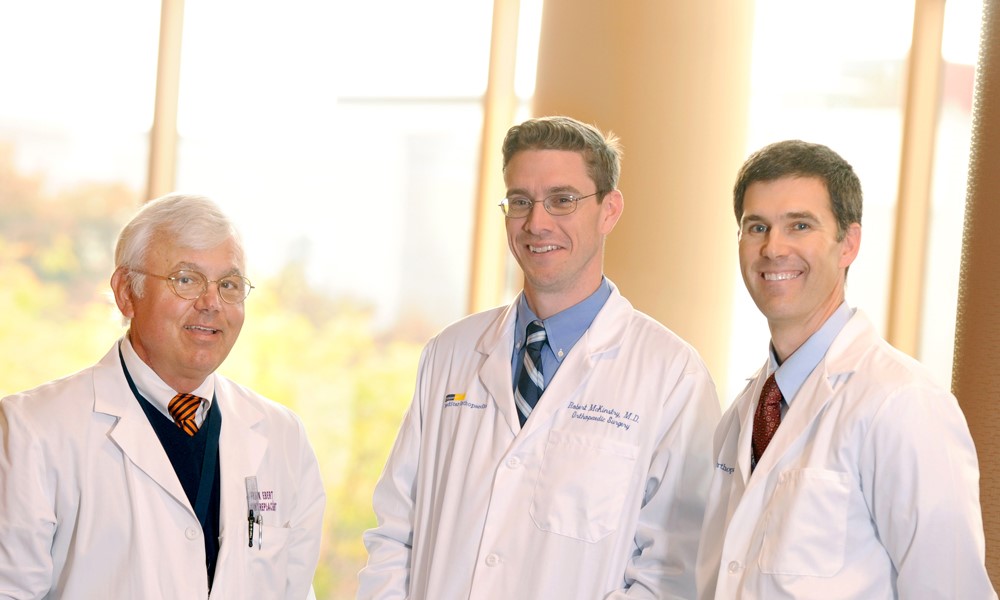What sets us apart?

Our hip and knee replacement program’s high quality and respected reputation has made us the leading choice in Central Maryland. Every year, we consistently perform more hip and knee replacement procedures than any other hospital in central Maryland – a testament to our clinical expertise. In 2015 alone, our surgeons performed more than 1,400 total joint replacements and U.S. News & World Report recognized us as a Best Hospital for orthopedics. We have earned Advanced Certification from The Joint Commission for Hip and Knee Replacement, and are a Blue Cross Blue Shield Blue Distinction Center+ for Hip and Knee Replacement Surgery. Our surgical procedures include hip replacements, hip resurfacing, full and partial knee replacements, as well as corrections or replacements of formerly replaced joints.
Patients benefit from a complete program that includes classes and education, a dedicated patient care coordinator, special medication and anesthesia choices that reduce nausea and pain, highly trained nursing care, home care, and inpatient and outpatient therapy. Choosing to have joint replacement surgery with us typically results in a shorter hospital stay and faster recovery.
Related conditions
Knee pain
Knee pain is a common problem that can originate in any of the bony structures compromising the knee joint, the kneecap, or the ligaments and cartilage of the knee. Knee pain can affect people of all ages. It may be…
Loosening of the knee prosthesis
In order for a total knee replacement to function properly, the implant or prosthesis must remain firmly attached to the bone. Over time, however, an implant may loosen from the underlying bone, causing the knee to become painful. The cause…
Osteoarthritis (Knee)
Many people develop osteoarthritis during middle age or older. A common condition, it can occur in any joint in the body, but most often develops in weight-bearing joints, such as the knee. Knee arthritis causes pain and stiffness. It can…
Osteoarthritis (Hip)
Osteoarthritis of the hip is a common condition that many people develop during middle age or older. It can occur in any joint in the body, but most often develops in weight-bearing joints, such as the hip. Hip arthritis causes…
Avascular necrosis (Hip)
Avascular necrosis of the hip occurs when a part of the bone dies as the result of loss of its blood supply. The lack of blood may cause the surface of the bone to collapse, and arthritis will result. The…
Related treatments
Robotic joint replacement
When it comes to total hip and knee replacement, the right fit is everything. MedStar Health offers MAKOplasty—a unique robotic joint replacement that is changing the lives of patients for the better. Now, we are performing more MAKOplasty procedures than…
Total knee revision
Total knee replacement is one of the most successful procedures in all of medicine. In the vast majority of cases, it enables people to live richer, more active lives free of chronic knee pain. Knee replacements may last your entire…
Total knee replacement
At MedStar Health, we offer a variety of advanced total knee replacement care and treatment options for patients with knees affected by arthritis, osteoporosis, or other diseases. Our leading-edge procedures provide more precise surgery, faster recovery times, improved…
Total hip revision
Hip replacements are designed to last for many years. But sometimes they can wear out due to natural use over time or an infection that can develop in nearby tissues. Hip revision surgery is performed to repair an artificial hip…
Total hip replacement
Total hip replacement surgery, also called total hip arthroplasty, is used to relieve pain and restore function to patients whose joints have been destroyed by trauma or condition such as arthritis...
Procedures

Joint Replacement
At MedStar Health, we offer a wide variety of options for joint replacement. Our team of experts will evaluate your unique situation and recommend the best option for you.
Robotic joint replacement using MAKOplasty
MAKOplasty is a computer assisted, three-dimensional planning and guidance tool that gives surgeons the ability to develop a pre-operative plan for each patient, as well as optimizing the fit of the joint replacement during the surgery itself. It is also referred to as robotic joint replacement.
Computer-assisted knee replacement
An infrared camera, computer, and software allows surgeons to place the new joint in the precise place, optimizing the recovery of the patient. Now, the computer helps guide the surgeon through cuts, bones, and implant positioning.
Rotating Platform Knee replacement
Rotating Platform Knees are designed to allow the knee to slightly rotate while it flexes and extends.
Unicompartmental Knee Replacement
A painful knee can hinder you from leaving a full active life. Partial knee joint replacement or Unicompartmental Knee Replacement is less invasive than a full knee joint replacement. The operation is designed to replace only the portions of the joint that are most damaged by arthritis, so it reduces pain and recovery time while achieving a comfortable range of motion.
Benefits include:
-
Smaller incision: A traditional knee joint replacement surgery involves an incision about 8 inches over the front of the knee. In the minimally invasive partial knee replacement, the incision is about 3 inches, and the amount of dissection and bone removal is much smaller.
-
Less blood loss: Because of the extent of dissection and bone removal necessary for a total knee joint replacement, the need for a blood transfusion is relatively common. With the unicompartmental knee procedure, a blood transfusion is not as common, and patients do not need to consider giving blood preoperatively.
-
Shorter recovery: With traditional total knee joint replacements, patients spent three or four days in the hospital and often required a stay in an inpatient rehabilitation unit. Both the time in the hospital and the time to functional recovery are less with the partial knee replacement. Patients are known to have been discharged on the day of the procedure.
Learn more about knee replacement surgery options.
Hip replacement surgery
The goal of hip replacement surgery is to help relieve your pain and improve your quality of life. In a total hip replacement surgery, the painful parts of the damaged hip are replaced with artificial hip parts called a prosthesis, a device that substitutes or supplements a joint. The prosthesis consists of three components: a socket, ball, and stem. The outer shell of the socket is usually made of metal and the inner shell consists of plastic or the entire socket may be plastic. When the metal ball is joined with the socket, the new hip allows for smooth, nearly frictionless movement.
Learn more about hip replacement surgery.
Videos
Relief from joint pain starts here
Don’t let knee or hip pain stop you from living your best life. Take one of our free assessments below to learn about your treatment options.
Our providers
Location: Enter your location
Hip and Knee Orthopedic Surgery
-
Henry Robert Boucher, MD
Hip And Knee Orthopedic Surgery & Orthopedic Surgery
-
Frank Ross Ebert, MD
Hip And Knee Orthopedic Surgery
-
Mark David Hasenauer, MD
Hip And Knee Orthopedic Surgery & Orthopedic Surgery
-
Brett Russell Levine, MD, MMS
Hip And Knee Orthopedic Surgery
-
Robert P McKinstry, MD
Hip And Knee Orthopedic Surgery
-
Afamefuna Maxwell Nduaguba, MD
Hip And Knee Orthopedic Surgery
-
Ahamefula Elemuwa Onyike, MD
Hip And Knee Orthopedic Surgery
-
Kevin Woo Park, MD
Hip And Knee Orthopedic Surgery
-
Thomas Milleret Ring, MD
Knee Orthopedic Surgery, Hip Orthopedic Surgery, Hip And Knee Orthopedic Surgery & Orthopedic Surgery
-
Angela Lee Tomaschko, MD
Hip And Knee Orthopedic Surgery
-
Kenneth M Vaz, MD
Hip And Knee Orthopedic Surgery
Orthopedic Sports Medicine
-
Emmanuel Asare O Atiemo, MD
Orthopedic Sports Medicine
-
Vestinia Madonna Bridges, MD
Orthopedic Sports Medicine
-
Emily T. Cha, MD
Orthopedic Sports Medicine
-
Leigh Ann Curl, MD
Sports Medicine & Orthopedic Sports Medicine
-
Wiemi Abell Douoguih, MD
Orthopedic Sports Medicine
-
James C. Dreese, MD
Sports Medicine & Orthopedic Sports Medicine
-
Allison Liefeld Fillar, MD
Sports Medicine, Orthopedic Sports Medicine & Orthopedic Surgery
-
Richard Yarborough Hinton, MD
Pediatric Sports Medicine, Shoulder Orthopedic Surgery, Knee Orthopedic Surgery, Sports Medicine & Orthopedic Sports Medicine
-
Richard Gary Levine, MD
Knee Orthopedic Surgery, Shoulder Orthopedic Surgery, Sports Medicine & Orthopedic Sports Medicine
-
Christopher Alan Looze, MBBS, MD
Sports Medicine & Orthopedic Sports Medicine
-
Milford Howarth Marchant, MD
Orthopedic Surgery, Orthopedic Sports Medicine & Sports Medicine
-
Carter Wallace Mitchell, MD
Orthopedic Sports Medicine
-
Ryan Stephen Murray, MD
Sports Medicine, Orthopedic Sports Medicine, Pediatric Sports Medicine & Pediatric Orthopedic Surgery
-
Steven James Svoboda, MD
Orthopedic Sports Medicine
-
Kenneth Benjamin Tepper, MD
Orthopedic Sports Medicine & Sports Medicine
-
Melissa Ann Yadao, MD
Orthopedic Sports Medicine










